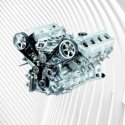Engines
Deutz

Engines description
Engine, in general terms, is an apparatus that converts energy into mechanical motion. The most common type of engine is a gasoline or diesel engine, which is used to power cars, trucks, boats, and other machines. There are also alternative types of engines, such as electric motors and steam engines.
Internal Combustion Engines
The most common type of engine is the internal combustion engine, which converts energy into mechanical motion by burning a fuel, such as gasoline or diesel, in a closed cylinder. This type of combustion creates a great deal of heat, which is then converted into mechanical energy. Internal combustion engines can be classified into two-stroke and four-stroke engines, depending on the number of strokes a piston takes to complete a cycle.
Two-Stroke Engines
A two-stroke engine is a type of internal combustion engine that has only two strokes, or cycles, to complete a power cycle. The two strokes are the intake stroke and the power stroke. The intake stroke is where air and fuel are drawn into the cylinder and the power stroke is where the compressed air-fuel mixture is ignited and the resulting power is used to power the engine. Two-stroke engines are typically used in smaller applications, such as chainsaws and outboard motors.
Four-Stroke Engines
A four-stroke engine is a type of internal combustion engine that has four strokes, or cycles, to complete a power cycle. The four strokes are the intake stroke, the compression stroke, the power stroke, and the exhaust stroke. The intake stroke is where air and fuel are drawn into the cylinder, the compression stroke is where the air-fuel mixture is compressed, the power stroke is where the compressed air-fuel mixture is ignited and the resulting power is used to power the engine, and the exhaust stroke is where the exhaust gases are expelled from the engine. Four-stroke engines are typically used in larger applications, such as automobiles and motorcycles.
Advantages and Disadvantages of Internal Combustion Engines
Internal combustion engines have some advantages and disadvantages. On the plus side, they are relatively simple to maintain and are more efficient than other types of engines. On the downside, they produce a great deal of emissions, which can be harmful to the environment. Additionally, they require a fuel source, such as gasoline or diesel, which can be expensive.
Electric Motors
An electric motor is an electrical machine that converts electrical energy into mechanical energy. It is a type of engine that uses electricity as its power source instead of fuel. Electric motors are typically used in smaller applications, such as fans and electric vehicles, and can be powered by batteries, fuel cells, or photovoltaic cells.
Advantages and Disadvantages of Electric Motors
Electric motors have some advantages and disadvantages. On the plus side, they are very efficient, produce no emissions, and can be powered by renewable energy sources. On the downside, they require a large initial investment, are expensive to maintain, and can be affected by power outages.
Order spare parts for engines
If you do not know the part number of the spare part you need, then we will try to help you with the selection of spare parts for your engines . To do this, please fill out the form below and be sure to include the model and the serial number of your machine.
We also use analytics & advertising services. To opt-out click for more information.